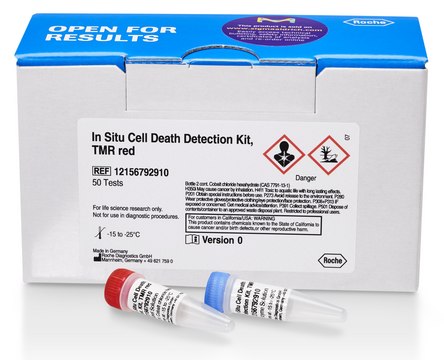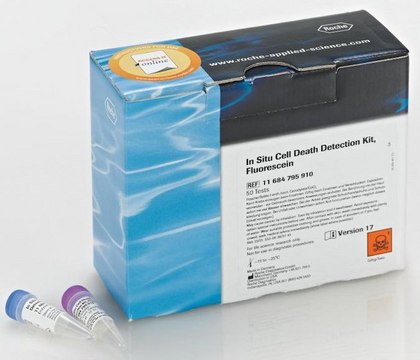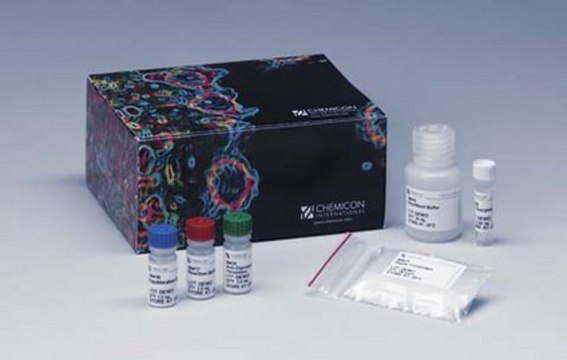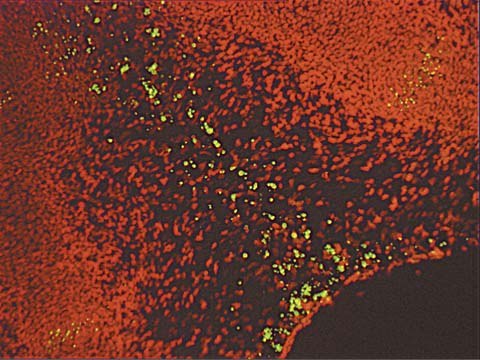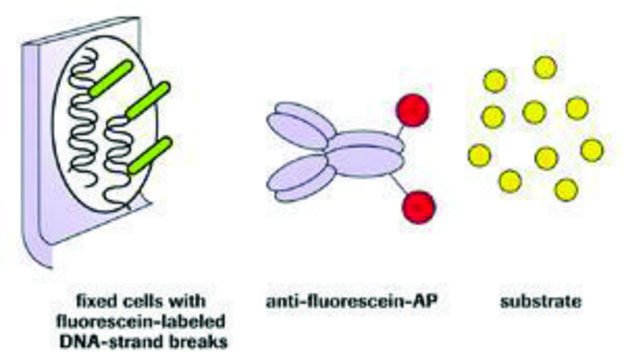11966006001
Roche
TUNEL Dilution Buffer
pH 7.2-7.4 (20 °C), suitable for detection, pkg of 2 × 10 mL
Synonym(s):
TUNEL, transferase dUTP nick end labeling
Sign Into View Organizational & Contract Pricing
All Photos(1)
About This Item
UNSPSC Code:
41116100
Recommended Products
packaging
pkg of 2 × 10 mL
manufacturer/tradename
Roche
pH
7.2-7.4 (20 °C)
application(s)
detection
storage temp.
2-8°C
General description
The TUNEL dilution buffer can be used in combination with the in-situ cell death detection kits. It can be used to dilute terminal deoxynucleotidyl transferase (TdT) for the TUNEL reaction in special applications and also to label DNA strand breaks for detecting and quantitating apoptotic cell death at the single-cell level in cells and tissues.
Application
TUNEL Dilution Buffer has been used:
- to dilute terminal deoxynucleotidyl transferase dUTP nick end labeling (TUNEL) enzyme (TdT) in preparing TUNEL reaction mixture for TUNEL critical commercial assays
- to quantify apoptosis in rat kidney
- to dilute the terminal deoxynucleotidyl transferase enzyme solution to identify DNA fragmentation in oligodendrocytes in vitro
- for TUNEL assays
TUNEL dilution buffer has been used in terminal deoxynucleotidyl transferase dUTP nick end labeling (TUNEL) assays.
Preparation Note
Working concentration: Working concentration of conjugate depends on application and substrate.
The following concentrations should be taken as a guideline:
Storage conditions (working solution): Dilutions of TdT should be prepared immediately before use and should not be stored.
Keep TUNEL reaction mixture on ice until use.
The following concentrations should be taken as a guideline:
- ELISA: 100 mU/ml
- Western blot: 100mU/ml
Storage conditions (working solution): Dilutions of TdT should be prepared immediately before use and should not be stored.
Keep TUNEL reaction mixture on ice until use.
Other Notes
For life science research only. Not for use in diagnostic procedures.
Signal Word
Danger
Hazard Statements
Precautionary Statements
Hazard Classifications
Aquatic Chronic 3 - Carc. 1B Inhalation
Storage Class Code
6.1D - Non-combustible acute toxic Cat.3 / toxic hazardous materials or hazardous materials causing chronic effects
WGK
WGK 2
Flash Point(F)
does not flash
Flash Point(C)
does not flash
Choose from one of the most recent versions:
Already Own This Product?
Find documentation for the products that you have recently purchased in the Document Library.
Preclinical characterization of abemaciclib in hormone receptor positive breast cancer.
Torres-Guzman R, et al.
Oncotarget, 8(41), 69493-69493 (2017)
Jiarui Han et al.
Drug design, development and therapy, 14, 3223-3234 (2020-08-28)
Inflammation-induced podocyte apoptosis plays an important role in kidney injury during diabetic nephropathy (DN). Hirudin (HIR), a natural compound extracted from leeches, can inhibit inflammation. However, whether HIR can protect the kidneys against inflammation during DN is unknown. In the
Yoshiki Hayashi et al.
Proceedings of the National Academy of Sciences of the United States of America, 101(28), 10338-10342 (2004-07-09)
Nanos (Nos) is one of the evolutionarily conserved proteins known to direct germ-line development. In Drosophila, maternal Nos protein maintains transcriptional quiescence in the germ-line progenitors or pole cells to repress ectopic expression of somatic genes. Here we show that
Karolina Kleinsimlinghaus et al.
Frontiers in cellular neuroscience, 7, 277-277 (2014-01-15)
The aim of the present study has been to obtain high yields of oligodendrocyte precursor cells (OPCs) in culture. This is a first step in facilitation of myelin repair. We show that, in addition to factors, known to promote proliferation
Anna Lm Smith et al.
Nature cancer, 1(10), 976-989 (2020-10-20)
Oxidative phosphorylation (OXPHOS) defects caused by somatic mitochondrial DNA (mtDNA) mutations increase with age in human colorectal epithelium and are prevalent in colorectal tumours, but whether they actively contribute to tumorigenesis remains unknown. Here we demonstrate that mtDNA mutations causing
Our team of scientists has experience in all areas of research including Life Science, Material Science, Chemical Synthesis, Chromatography, Analytical and many others.
Contact Technical Service